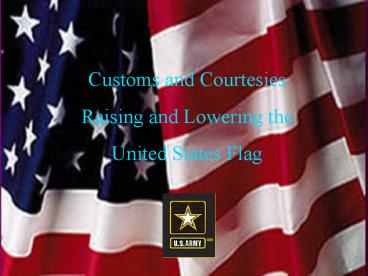DOIM COMMAND BRIEF - PowerPoint PPT Presentation
1 / 13
Title:
DOIM COMMAND BRIEF
Description:
Title: DOIM COMMAND BRIEF Subject: TITLE PAGE Author: MAJOR SEAN M. CASEY Last modified by: MD-STARC-DOIM Created Date: 10/4/1996 12:59:12 PM Document presentation format – PowerPoint PPT presentation
Number of Views:173
Avg rating:3.0/5.0
Title: DOIM COMMAND BRIEF
1
Customs and Courtesies Raising and Lowering the
United States Flag
2
Informational Briefing Customs and Courtesies -
Raising and Lowering the United States Flag
Presented by SGT Jose Bulls
3
The purpose of this lesson is to briefly
familiarize the class in the U.S. Armys history
of its customs and courtesies, and how, why, and
when to raise and lower the U.S. Flag.
4
Customs and Courtesies
The two Army publications that cover or have
information regarding military customs and
courtesies are 1. FM 22-5 (Drill and
Ceremonies) 2. AR 600-25 Appendix A (Salutes,
Honors, and Visits of Courtesy)
5
What is Military Courtesy ?
The respect and consideration shown by military
personnel to others. What is considered to be
the most important of all military courtesies
? The hand salute. In early roman history,
persons meeting would raise their hands in the
air, palm forward to show that they held no
weapons and were friendly. This has evolved into
the present day salute.
6
Some Protocols of a Military Salute
- You should render a salute approximately six
paces from the approaching officer, and hold the
salute until returned by the officer. - Salutes are not required when actively
participating in physical fitness training. - You are required to salute a non - commissioned
officer when reporting to the president of the
board, reporting in first formation and when
turning over a formation. - When outdoors, and you hear the national anthem
you should face the flag or the music if the flag
is not in view, and render the prescribed salute. - An officer should salute an NCO first when the
enlisted person is a Medal of Honor awardees.
7
Situations
Q While marching troops Retreat and To the
Colors sound. Who salutes ? A You would tell
your soldiers to HALT, face them towards the flag
or in the direction of the music. Call them to
parade rest while retreat is playing. When To
the colors begin, call the soldiers to attention
and all will present arms. Q While on gate
guard, a POV (Privately Owned Vehicle) approaches
and you recognize the driver to be a Captain.
What should be your reaction ? A The gate guard
will salute. Q It is 1700 hours and you are the
only only one inside your office. Retreat
and To the colors sound, what should you do
? A Come to the position of attention facing the
sound of the music.
8
Examples of Military Courtesy
When reporting indoors, remove headgear (except
under arms), approach to within two paces of the
desk, halt, salute and report. Sir / Maam, SGT
Snuffy reports. When walking outdoors, the
junior ranking soldier should always walk to the
left of the senior officer. When entering a
military vehicle, the junior NCO/Officer enters
first and the senior NCO/Officer second, so when
its time to dismount the vehicle the senior
NCO/Officer leaves first.
9
Flag Facts and Protocols
- The Flag Code, which formalizes and unifies the
traditional ways in which we give respect to the
flag, also contains specific instructions on how
the flag is not to be used. They are - The flag should never be dipped to any person or
thing. It is flown upside down only as a distress
signal. - The flag should not be used as a drapery, or for
covering a speakers desk, draping a platform, or
for any decoration in general. Bunting of blue,
white and red stripes is available for these
purposes. The blue stripe of the bunting should
be on the top. - The flag should never be used for any
advertising purpose. It should not be
embroidered, printed or otherwise impressed on
such articles as cushions, handkerchiefs,
napkins, boxes, or anything intended to be
discarded after temporary use. Advertising signs
should not be attached to the staff or halyard.
10
Flag Facts and Protocols (continued)
- The flag should not be used as part of a costume
or athletic uniform, except that a flag patch may
be used on the uniform of military personnel,
fireman, policeman and members of patriotic
organizations. - The flag should never have placed on it, or
attached to it, any mark, insignia, letter, word,
number, figure, or drawing of any kind. - The flag should never be used as a receptacle for
receiving, holding, carrying, or delivering
anything.
11
Raising and Lowering the flag
- The flag should be raised briskly and lowered
slowly and ceremoniously. Ordinarily it should be
displayed only between sunrise and sunset. It
should be illuminated if displayed at night. - The flag of the United States of America is
saluted as it is hoisted and lowered. The salute
is held until the flag is unsnapped from the
halyard or through the last note of music,
whichever is the longest.
12
The Flag in Mourning
To place the flag at half staff, hoist it to the
peak for an instant and lower it to a position
half way between the top and bottom of the staff.
The flag is to be raised again to the peak for a
moment before it is lowered. On Memorial Day the
flag is displayed at half staff until noon and at
full staff from noon to sunset. The flag is to
be flown at half staff in mourning for
designated, principal government leaders and upon
presidential or gubernatorial order. When used
to cover a casket, the flag should be placed with
the union at the head and over the left shoulder.
It should not be lowered into the grave.
13
This concludes my informational briefing.

